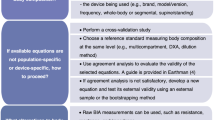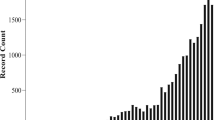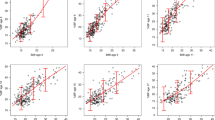Abstract
Background:
Bio-electrical impedance analysis (BIA) is widely used to estimate body composition. It is simple, quick and cheap, but less accurate than other methods. It has potential epidemiological value, but has conventionally required validation before application.
Aims:
To develop a simple method of expressing weight, height and impedance data that avoids the need for population-specific validation equations in order to facilitate epidemiological application.
Methods:
Body composition was measured using the four-component model in young adults (43 males, 90 females). Impedance (R) was measured hand–foot and foot–foot. Lean mass and fat mass were adjusted for height to give lean mass index (LMI) and fat mass index (FMI). Based on theoretical principles, we generated the index 1/R, which provides an index of body water adjusted for height. Sex-specific regression models were used to investigate the relationships between (a) 1/R and LMI, and (b) body mass index (BMI) adjusted for 1/R and FMI. The success of this approach was evaluated in relation to the conventional BIA approach, using correlation analysis.
Results:
1/R was a highly significant predictor of LMI. BMI adjusted for 1/R was a significant predictor of FMI. Our approach performed as well as the conventional approach for LMI, but not for FMI.
Discussion:
Direct use of BIA data, rather than their combination with population-specific equations for the prediction of total body water, proved successful at ranking individuals of both sexes in terms of LMI and FMI. The index 1/R may prove particularly valuable in epidemiological studies where ranking of LMI is required.
This is a preview of subscription content, access via your institution
Access options
Subscribe to this journal
Receive 12 print issues and online access
$259.00 per year
only $21.58 per issue
Buy this article
- Purchase on Springer Link
- Instant access to full article PDF
Prices may be subject to local taxes which are calculated during checkout





Similar content being viewed by others
References
Coltorti A, Scalfi L, Borrelli R, Contaldo F, Diaz E . Validity of 5 bioelectric impedance equations for the estimation of lean body mass in women. Minerva Endocrinol 1991; 16: 37–41.
Davies PS, Joughin C . Assessment of body composition in the Prader–Willi syndrome using bioelectrical impedance. Am J Med Genet 1992; 44: 75–78.
Guricci S, Hartriyanti Y, Hautvast JGAJ, Deurenberg P . The prediction of extra cellular water and total body water by multi-frequency bio-electrical impedance in a South East Asian population. Asia Pacific J Clin Nutr 1999; 8: 155–159.
Deurenberg P, Deurenberg-Yap M, Schouten FJM . Validity of total and segmental impedance measurements for prediction of body composition across ethnic population groups. Eur J Clin Nutr 2002; 56: 214–220.
Wells JCK, Gigante D, Wright A, Hallal PC, Victora CG . Validation of leg-to-leg impedance for body composition assessment in male Brazilians aged 16–19 years. Int J Body Compos Res 2003; 1: 63–67.
Jebb SA, Cole TJ, Doman D, Murgatroyd P, Prentice AM . Evaluation of the novel Tanita body-fat analyser to measure body composition by comparison with a four-compartment model. Br J Nutr 2000; 83: 115–122.
Kotler DP, Burastero S, Wang J, Pierson RN . Prediction of body cell mass, fat-free mass, and total body water with bioelectrical impedance analysis: effects of race, sex, and disease. Am J Clin Nutr 1996; 64 (Suppl): 489S–497S.
Wells JCK, Fuller NJ, Dewit O, Fewtrell MS, Elia M, Cole TJ . Four-component model of body composition in children: density and hydration of fat-free mass and comparison with simpler models. Am J Clin Nutr 1999; 69: 904–912.
de Ridder CM, de Boer RW, Seidell JC, Nieuwenhoff CM, Jeneson JA, Bakker CJ et al. Body fat distribution in pubertal girls quantified by magnetic resonance imaging. Int J Obes Relat Metab Disord 1992; 16: 443–449.
Owens S, Litaker M, Allison J, Riggs S, Ferguson M, Gutin B . Prediction of visceral adipose tissue from simple anthropometric measurements in youths with obesity. Obes Res 1999; 7: 16–22.
Han TS, van Leer EM, Seidell JC, Lean ME . Waist circumference as a screening tool for cardiovascular risk factors: evaluation of receiver operating characteristics (ROC). Obes Res 1996; 4: 533–547.
Lean ME, Han TS, Seidell JC . Impairment of health and quality of life in people with large waist circumference. Lancet 1998; 351: 853–856.
Dewit O, Fuller NJ, Fewtrell MS, Elia M, Wells JC . Whole body air displacement plethysmography compared with hydrodensitometry for body composition analysis. Arch Dis Child 2000; 82: 159–164.
Wells JC, Fuller NJ . Precision of measurement and body size in whole-body air-displacement plethysmography. Int J Obes Relat Metab Disord 2001; 25: 1161–1167.
Scrimgeour CM, Rollo MM, Mudambo SM, Handley LL, Prosser SJ . A simplified method for deuterium/hydrogen isotope ratio measurements on water samples of biological origin. Biol Mass Spectrom 1993; 22: 383–387.
Racette SB, Schoeller DA, Luke AH, Shay K, Hnilicka J, Kushner RF et al. Relative dilution spaces of 2H- and 18O-labeled water in humans. Am J Physiol 1994; 267: E585–E590.
Kushner RF, Schoeller DA, Fjeld CR, Danford L . Is the impedance index (ht2/R) significant in predicting total body water? Am J Clin Nutr 1992; 56: 835–839.
Fuller NJ, Jebb SA, Laskey MA, Coward WA, Elia M . Four-component model for the assessment of body composition in humans: comparison with alternative methods, and evaluation of the density and hydration of fat-free mass. Clin Sci 1992; 82: 687–693.
Van Itallie TB, Yang M, Heymsfield SB, Funk RC, Boileau RA . Height-normalised indices of the body's fat-free and fat mass: potentially useful indicators of nutritional status. Am J Clin Nutr 1990; 52: 953–959.
Wells JCK . A critique of the expression of paediatric body composition data. Arch Dis Child 2001; 85: 67–72.
Wells JCK, Cole TJ, ALSPAC Study Team. Adjustment of fat-free mass and fat mass for height in children aged 8 years. Int J Obes Relat Metab Disord 2002; 26: 947–952.
Wells JCK, Victora CG . Indices of whole-body and central adiposity for evaluating the metabolic load of obesity. Int J Obes Relat Metab Disord 2005; 29: 483–489.
Gasser T, Ziegler P, Seifert B, Prader A, Molinari L, Largo R . Measures of body mass and of obesity from infancy to adulthood and their appropriate transformation. Ann Hum Biol 1994; 21: 111–125.
Pietrobelli A, Faith MS, Allison DB, Gallagher D, Chiumello G, Heymsfield SB . Body mass index as a measure of adiposity among children and adolescents: a validation study. J Pediatr 1998; 132: 204–210.
Chan YL, Leung SSF, Lam WWM, Peng XH, Metreweli C . Body fat estimation in children by magnetic resonance imaging, bioelectrical impedance, skinfold and body mass index: a pilot study. J Paediatr Child Health 1998; 34: 22–28.
Wells JCK . A Hattori chart analysis of body mass index in infants and children. Int J Obes Relat Metab Disord 2000; 24: 325–329.
Garrow JS, Webster J . Quetelet's index (W/H2) as a measure of fatness. Int J Obes 1985; 9: 147–153.
Hattori K, Tatsumi N, Tanaka S . Assessment of body composition by using a new chart method. Am J Hum Biol 1997; 9: 573–578.
Clarke MS . The effects of exercise on skeletal muscle in the aged. J Musculoskelet Neuronal Interact 2004; 4: 175–178.
Schutz Y, Kyle UU, Pichard C . Fat-free mass index and fat mass index percentiles in Caucasians aged 18–98 y. Int J Obes Relat Metab Disord 2002; 26: 953–960.
Pichard C, Kyle UG, Morabia A, Perrier A, Vermeulen B, Unger P . Nutritional assessment: lean body mass depletion at hospital admission is associated with an increased length of stay. Am J Clin Nutr 2004; 79: 613–618.
Singhal A, Wells J, Cole TJ, Fewtrell M, Lucas A . Programming of lean body mass: a link between birth weight, obesity, and cardiovascular disease? Am J Clin Nutr 2003; 77: 726–730.
Wells JCK, Hallal PR, Wright A, Singhal A, Victora CG . Fetal, infant and childhood growth: relationships with body composition in Brazilian boys aged 9 years. Int J Obes Relat Metab Disord 2005; 29: 1192:8–1198.
Norgan NG, Ferro-Luzzi A . Weight–height indices as estimates of fatness in men. Hum Nutr Clin Nutr 1982; 36C: 363–372.
Author information
Authors and Affiliations
Corresponding author
Rights and permissions
About this article
Cite this article
Wells, J., Williams, J., Fewtrell, M. et al. A simplified approach to analysing bio-electrical impedance data in epidemiological surveys. Int J Obes 31, 507–514 (2007). https://doi.org/10.1038/sj.ijo.0803441
Received:
Revised:
Accepted:
Published:
Issue Date:
DOI: https://doi.org/10.1038/sj.ijo.0803441
Keywords
This article is cited by
-
Reference values for body composition in healthy urban Mexican children and adolescents
European Journal of Clinical Nutrition (2023)
-
Associations of age and body mass index with hydration and density of fat-free mass from 4 to 22 years
European Journal of Clinical Nutrition (2019)
-
International Collaboration for the Epidemiology of eGFR in Low and Middle Income Populations - Rationale and core protocol for the Disadvantaged Populations eGFR Epidemiology Study (DEGREE)
BMC Nephrology (2017)
-
DXA, bioelectrical impedance, ultrasonography and biometry for the estimation of fat and lean mass in cats during weight loss
BMC Veterinary Research (2012)



